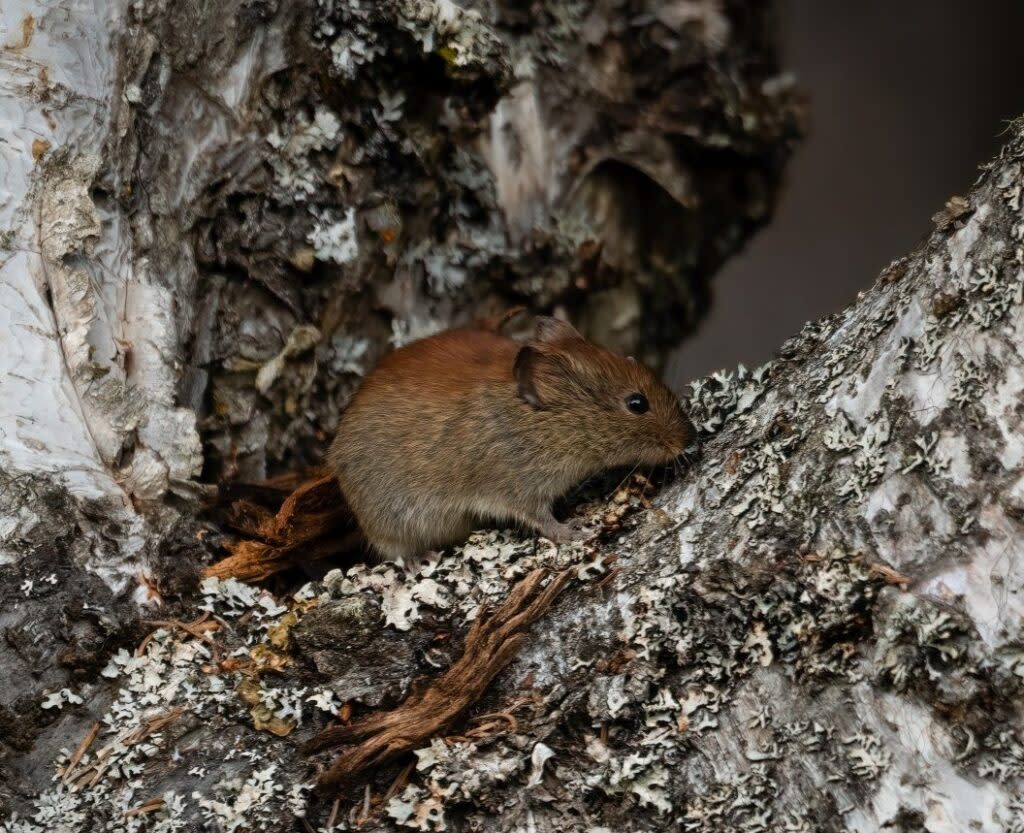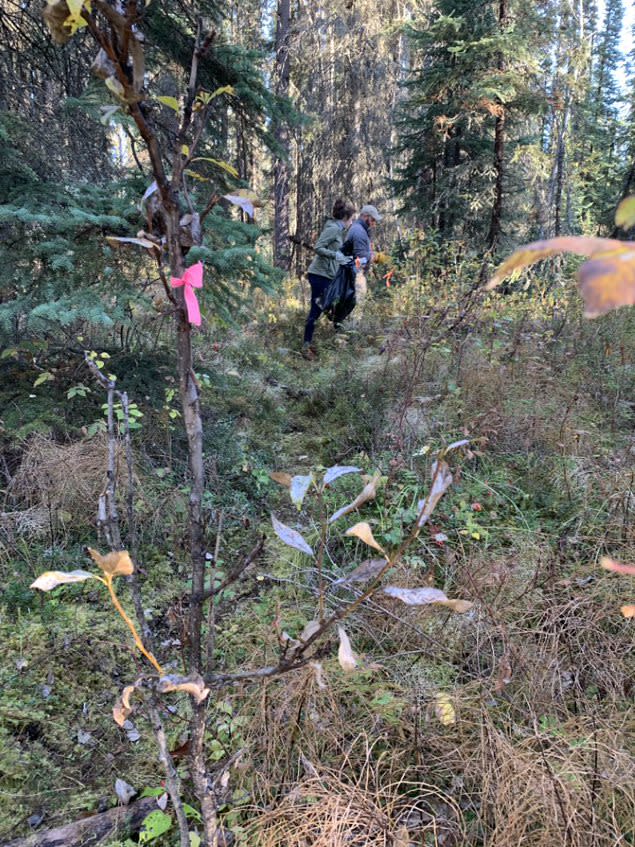Alaskapox no more: Newly discovered disease and virus is to be called ‘borealpox’

A northern red-backed vole scampers through a forested area of the Kenai Peninsula. These small mammals, found in almost all parts of Alaska, are known carriers of the virus that causes the disease being renamed borealpox. The borealpox virus -- known up to now as the Alaskapox virus -- appears to be more widespread in the environment than previously understood. (Photo by Colin Canturbury/U.S. Fish and Wildlife Service)
The viral, rash-causing and headline-grabbing disease that was first diagnosed in Fairbanks in 2015 is getting a new name: borealpox.
Known up to now as Alaskapox, the disease is caused by a virus in the orthopox family that includes smallpox and other pox viruses.
There are only seven known cases to date, six in Fairbanks that resulted in relatively mild effects that resolved on their own and one on the Kenai Peninsula that led to the death of an elderly man whose immune system was weakened after treatments for cancer.
News of the name change came from Katherine Newell, a U.S. Centers for Disease Control and Prevention epidemiology field officer working at the Alaska Department of Health, who spoke at a conference hosted by the Alaska Native Tribal Health Consortium.
“We are changing the name of Alaskapox virus to borealpox virus, which is what it will now be known as from now on,” Newell said in a presentation Tuesday at the Alaska Tribal Conference on Environmental Management held in Anchorage.
There are two reasons for the name change, which is already shown on the Alaska Department of Health’s website and is expected to be made official in coming weeks by the CDC and the World Health Organization, she said.
One reason is scientific. While the discovery is new and the only cases found to date have been in Alaska, there is mounting evidence that the virus has been circulating in populations of small mammals for decades – and is expected to be in boreal regions beyond Alaska.
“While we’re only had cases to date in Fairbanks and now in Kenai, it’s likely that this virus probably is endemic throughout most of the state, if not the state, and also into Canada and potentially other regions as well,” Newell said.
The fatal Kenai case, which elevated Alaskapox from a scientific curiosity into a more serious issue, provided some key evidence about the wider range. The virus identified there was different genetically from the virus found in the Fairbanks area, indicating wider geographic dispersal over a longer timeframe.
Other evidence comes from the vast collection of northern animals kept at the University of Alaska Museum of the North.

The Univesity of Alaska Museum of the North is seen on Sept. 18, 2022. Several red-backed voles in the museum’s vast collection of specimens have tested positive for the borealpox virus, also known as the Alaskapox virus. (Photo by Yereth Rosen/Alaska Beacon)
Several of the museum’s northern red-backed vole specimens, including one collected more than 25 years ago from Denali National Park and Preserve, tested positive for the virus, said Link Olson, the museum’s curator of mammals and a former biology professor at the University of Alaska Fairbanks.
“It’s been circulating for a while. How long is a while? No one knows,” said Olson, who was a coauthor of the scientific study that first described Alaskapox and the 2015 human case.
The second reason to change the name to borealpox is more philosophical. The WHO in 2015 took a stance against naming newly discovered human diseases after geographic areas to avoid unfair stigmas.
Geographic disease names can be inaccurate. That was famously the case for the influenza pandemic that killed an estimated 50 million people starting in 1918. Despite being first diagnosed in Kansas, that disease came to be known as the “Spanish flu.”
Some geographic disease names are already too entrenched to change, Newell said. Some examples are Ebola, first discovered near the Ebola River in the Democratic Republic of Congo; West Nile virus, which first emerged in the West Nile district of Uganda; and Lyme disease, discovered in and around Lyme, Connecticut.
But the discovery and naming of Alaskapox and the virus that causes it is new enough that a name change can be made effectively, Newell said.
The WHO’s 2015 recommendations also advised against using animal names for newly discovered human diseases. Thus the disease originally known as monkeypox, to which Alaskapox is related, has now been officially renamed mpox.
For the Alaskapox/borealpox virus, red-backed voles and other small mammals scurrying around the forest appear to be the reservoir. But it took a few years to pin that down.
In 2015, after the first case was identified, Olson and Aren Gunderson, manager of the museum’s mammal collection, trapped some small mammals on the woodsy property where the patient had been living. None of the trapped animals tested positive for the virus.
In 2020 and 2021, after additional cases were identified, Olson, Newell and others fanned out into the woods in the Fairbanks area, where they trapped hundreds of small mammals of different species and tested them. Of the nearly 400 animals trapped and tested, 16% had antibodies showing past exposure to the virus and 5% had active infections of it, according to information presented by Newell at a CDC conference last year.
Northern red-backed voles dominated that group that tested positive, which made sense, Olson said.
Found in almost all of the state, they are extremely abundant — “one of Alaska’s most ubiquitous and common species,” according to the Alaska Department of Fish and Game’s species profile – so a lot of them wound up in the traps the scientists used to detect virus presence in small mammals. They also have very short lifespans, generally no more than 12 months, so they might not have time to overcome any viral infections they acquire, leaving those viruses still active when the animals are tested.

Katherine Newell and a colleague walk in September 2021 through the Fairbanks-area boreal forest, where they have set up traps for small mammals suspected of carrying the novel Alaskapox virus. It is being renamed borealpox. (Photo by Dr. Florence Whitehill/U.S. Centers for Disease Control and Prevention)
There is no evidence that Alaskapox/borealpox has harmed the animals it infected, Newell said. Among the hundreds of small mammals trapped, there was not even a single lesion, she said.
As for potential harm to people, the virus was considered to pose little threat, at least until the fatal Kenai Peninsula case occurred.
In the six Fairbanks North Star Borough cases, initial signs of infection were lesions that resembled spider bites, she said. In those Fairbanks-area cases, all among otherwise healthy people, symptoms included fatigue, swollen lymph nodes and fever – possibly uncomfortable, but not dangerous. All the Fairbanks patients recovered, some within a few days, though the skin lesions took longer to heal completely, according to state information.
In the aftermath of the fatal case, the Alaska Division of Health’s epidemiology section issued a set of recommendations that include extra precautions for people with compromised immune systems. State epidemiologists are also urging more public awareness, prompt reporting of any suspected cases and careful behavior around wild animals.
There is no evidence that the virus can spread between people. Pet dogs and cats that mingle with or prey on infected wild animals are considered possible transmitters. The Fairbanks-area patients owned pets, and the Kenai Peninsula man who eventually succumbed to the virus had been caring for a stray cat before his symptoms emerged, state health officials have noted.
Much more investigation is planned, including an expedition this summer to the Kenai Peninsula to trap and test animals there, Newell said. More discoveries of the virus are expected, she said.
“Until we had our fatal case in January of this year, people probably weren’t looking for it much,” Newell said.
Many questions remain unanswered. Among them: What other animal species, including bigger and longer-lived species, are carrying the Alaskapox/borealpox virus? Is there a reason why infections are just now showing up in people – or were there human cases in the past that went undiagnosed? How widespread is the virus in space, time and across various animal species?
Olson, who has just sent 100 specimen samples up to 20 years old to the CDC for testing, suspects that investigation into the last question will reveal much wider reach than originally believed.
“We should have never called it ‘Alaskapox,’” he said. And though he had advocated for the borealpox name from the start, even that may wind up being obsolete, he said. “I’ll go on record predicting it’s probably not going to be limited to the boreal region.”
GET THE MORNING HEADLINES DELIVERED TO YOUR INBOX
The post Alaskapox no more: Newly discovered disease and virus is to be called ‘borealpox’ appeared first on Alaska Beacon.

